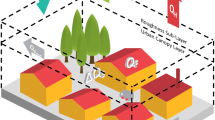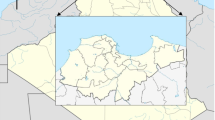Abstract
The main goal of this work is to describe the anthropogenic energy flux (Q F) in the city of São Paulo, Brazil. The hourly, monthly, and annual values of the anthropogenic energy flux are estimated using the inventory method, and the contributions of vehicular, stationary, and human metabolism sources from 2004 to 2007 are considered. The vehicular and stationary sources are evaluated using the primary consumption of energy based on fossil fuel, bio fuel, and electricity usage by the population. The diurnal evolution of the anthropogenic energy flux shows three relative maxima, with the largest maxima occurring early in the morning (∼19.9 Wm−2) and in the late afternoon (∼20.3 Wm−2). The relative maximum that occurs around noontime (∼19.6 Wm−2) reflects the diurnal pattern of vehicle traffic that seems to be specific to São Paulo. With respect to diurnal evolution, the energy flux released by vehicular sources (Q FV) contributes approximately 50% of the total anthropogenic energy flux. Stationary sources (Q FS) and human metabolism (Q FM) represent about 41% and 9% of the anthropogenic energy flux, respectively. For 2007, the monthly values of Q FV, Q FS, Q FM, and Q F are, respectively, 16.8 ± 0.25, 14.3 ± 0.16, 3.5 ± 0.03, and 34.6 ± 0.41 MJ m−2 month−1. The seasonal evolution monthly values of Q FV, Q FS, Q FM, and Q F show a relative minimum during the summer and winter vacations and a systematic and progressive increase associated with the seasonal evolution of the economic activity in São Paulo. The annual evolution of Q F indicates that the city of São Paulo released 355.2 MJ m−2 year−1 in 2004 and 415.5 MJ m−2 year−1 in 2007 in association with an annual rate of increase of 19.6 MJ m−2 year−1 (from 2004 to 2006) and 30.5 MJ m−2 year−1 (from 2006 to 2007). The anthropogenic energy flux corresponds to about 9% of the net radiation at the surface in the summer and 15% in the winter. The amplitude of seasonal variation of the maximum hourly value of the diurnal variation increases exponentially with latitude.











Similar content being viewed by others
Abbreviations
- A :
-
Urbanized area (m2)
- a Fuel :
-
Fraction of vehicles by fuel type
- C Electr :
-
Monthly consumption of electricity by stationary sources (GWh month−1)
- C Fuel :
-
Monthly consumption of fuel by vehicular or stationary sources (m3 month−1)
- E DPC :
-
Energy flux released from daily consumption of electricity by stationary sources (MJ m−2 day−1)
- EVFuel :
-
Energy released by vehicles per distance traveled and fuel type (J m−1)
- EVT :
-
Total energy released from fuel combustion of vehicles per traveled distance (J m−1)
- f :
-
Hourly fraction of the daily consumption of electricity by stationary sources
- FDPC :
-
Energy flux released from daily consumption of fuel by stationary sources (MJ m−2 day−1)
- FE:
-
Fuel economy (m l−1)
- F t :
-
Traffic fraction
- g :
-
Fraction of fuel consumption by stationary sources
- Lat:
-
Latitude (degree)
- M :
-
Rate of metabolic production of energy per person (W)
- n :
-
Number of persons or animals
- n D :
-
Number of days in the month
- NHCElectr :
-
Net heat released by the consumption of electricity by stationary sources (J KWh−1)
- NHCFuel :
-
Net heat released by fuel combustion per fuel type from vehicular or stationary sources (J kg−1)
- NWRP:
-
Number of residents (person)
- pcDVD:
-
Mean traveled distance of vehicles per person per day (m person−1 day−1)
- ρ Fuel :
-
Fuel density (kg m−3)
- ρ pop :
-
Population density (person m−2)
- Q*:
-
Net radiation
- Q F :
-
Anthropogenic energy flux
- Q MAXF :
-
Maximum hourly value of the diurnal evolution of Q F
- ΔQ S :
-
Heat storage
- Q H :
-
Turbulent sensible heat
- Q LE :
-
Turbulent latent heat
- ΔQ A :
-
Heat advection
- Q FM :
-
Anthropogenic energy flux released by human and animal metabolism
- Q FS :
-
Anthropogenic energy flux released by stationary sources
- Q FSE :
-
Anthropogenic energy flux released from the consumption of electricity by stationary sources
- Q FSF :
-
Anthropogenic energy flux released from the consumption of fuel by stationary sources
- Q FV :
-
Anthropogenic energy flux released by vehicular sources
- R 2 :
-
Coefficient of determination
- WP:
-
Number of nonresidents (person)
- CET:
-
Municipal Company of Transportation
- CETESB:
-
Environmental Protection Agency of the State of São Paulo
- DETRAN:
-
Department of Transportation of the State of São Paulo
- IAG:
-
Institute of Astronomy, Geophysics and Atmospheric Sciences
- IBGE:
-
Brazilian Institute of Geography and Statistics
- LPG:
-
Liquefied petroleum gas
- MRSP:
-
Metropolitan region of São Paulo City
- ONSE:
-
National Operator of the Brazilian Electric System
- SSE:
-
State of São Paulo Energy and Sanitation Agency
- UHI:
-
Urban heat island
References
Ântico C (2005) Displacements commuters in the metropolitan region of São Paulo. Available in Portuguese. São Paulo Perspect 19:110–120. doi:10.1590/S0102-88392005000400007
Aranha V (2005) Mobility commuting in metropolis in the city of São Paulo. Available in Portuguese. São Paulo Perspect 19:96–109. doi:10.1590/S0102-88392005000400006
Arnfield AJ (2003) Two decades of urban climate research: a review of turbulence, exchanges of energy and water and the urban heat island. Int J Climatol 23:1–26. doi:10.1002/joc.859
CETESB (2005) Report of air quality in the State of São Paulo 2004. Report CETESB, São Paulo. Available online, in Portuguese, at www.cetesb.sp.gov.br. 142 pp
CETESB (2006) Report of air quality in the State of São Paulo 2005. Report CETESB, São Paulo. Available online, in Portuguese, at www.cetesb.sp.gov.br. 153 pp
CETESB (2007) Report of air quality in the State of São Paulo 2006. Report CETESB, São Paulo. Available online, in Portuguese, at www.cetesb.sp.gov.br. 184 pp
CETESB (2008) Report of air quality in the State of São Paulo 2007. Report CETESB, São Paulo. Available online, in Portuguese, at www.cetesb.sp.gov.br. 298 pp
Codato G, Oliveira AP, Soares J, Escobedo JF, Gomes EN, Pai AD (2008) Global and diffuse solar irradiances in urban and rural areas in Southeast of Brazil. Theor Appl Climatol 93:57–73. doi:10.1007/s00704-007-0326-0
Collier CG (2006) The impact of urban areas on weather. Q J R Meteorol Soc 132:1–25. doi:10.1256/qj.05.199
DETRAN (2008) Monthly and annual evolution of the fleet vehicle. Available online, in Portuguese, at http://www.detran.sp.gov.br/
Ferreira MJ, Oliveira AP, Soares J, Bárbaro EW, Codato G, Marciotto ER, Silva M (2007) Evolution diurnal of the surface radiation balance of the city of São Paulo, Brazil. 8°Congreso Iberoamericano de Ingenieria Mecanica, 2007, Cusco–Peru, Available online in Portuguese. Anais do 8°Congreso iberoamericano de ingenieria mecanica, 2007. Available online at http://www.pucp.edu.pe/congreso/cibim8/aspectos.html
Fulton PN (1984) Estimating the daytime population with the urban transportation planning package. Transp Res Rec 981:25–27
Grimmond CSB (1992) The suburban energy balance: methodological considerations and results for a Mid-Latitude west coast city under winter and spring conditions. Int J Climatol 12:481–497. doi:10.1002/joc.3370120506
Hallenbeck M, Rice M, Smith B, Cornell-Martinez C, Wilkinson J (1997) Vehicle volume distribution by classification. Washington State Transportation Center. Available online at http://depts.washington.edu/trac, University of Washington, 1107 NE 45th St. Suite 535, Seattle WA 98105, 54 pp
IBGE (2008) Demographics Census. Available online at http://www.ibge.gov.br/english/
Ichinose T, Shimodozono K, Hanaki K (1999) Impact of anthropogenic heat on urban climate in Tokyo. Atmos Environ 33:3897–3909. doi:10.1016/S1352-2310(99)00132-6
Kłysik K (1996) Spatial and seasonal distribution of anthropogenic heat emissions in Łódź, Poland. Atmos Environ 30:3397–3404. doi:10.1016/1352-2310(96)00043-X
Lents J, Davis N, Nikkila N, Osses M (2004) São Paulo vehicle activity study, Available online at http://www.issrc.org/ive/, International Vehicle Emissions Model
Mills G (2007) Cities as agents of global change. Int J Climatol 27(14):1849–1857. doi:10.1002/joc.1604
Monteiro CAF (1976) Teoria e clima urbano In: Série Teses e Monografias, n.25—Instituto de Geografia, Faculdade de Filosofia, Letras e Ciências Humanas, Universidade de São Paulo, São Paulo pp 181
Oke TR (1988) The urban energy balance. Prog Phys Geogr 12:471–508. doi:10.1177/030913338801200401
Oliveira AP, Escobedo JF, Machado AJ, Soares J (2002) Diurnal evolution of solar radiation at the surface in the city of São Paulo: seasonal variation and modeling. Theor Appl Climatol 71:231–249. doi:10.1007/s007040200007
ONSE (2008) Energetic Bulletin. Available online in Portuguese, at http://www.ons.org.br/download/analise_carga_demanda/Relatorio_Anual_08-09-Carga.pdf
Pigeon G, Legain D, Durand P, Masson V (2007) Anthropogenic heat release in an old European agglomeration (Toulouse, France). Int J Climatol 27:1969–1981. doi:10.1002/joc.1530
Roson AC (2008) Personal communication
Sailor DJ, Lu L (2004) A top-down methodology for developing diurnal and seasonal anthropogenic heating profiles for urban areas. Atmos Environ 38:2737–2748. doi:10.1016/j.atmosenv.2004.01.034
Sailor DJ, Hart M (2006) An anthropogenic heating database for major U.S. cities. Proceedings of the Sixth Symposium on the Urban Environment. American Meteorological Society, Atlanta, January 28–February 2, Paper 5.6. Available online at http://ams.confex.com/ams/pdfpapers/105377.pdf
Silva FIA, Guerra SMG (2009) Analysis of the energy intensity evolution in the Brazilian industrial sector—1995 to 2005. Renewable Sustainable Energy Rev 13:2589–2596. doi:10.1016/j.rser.2009.01.003
Smith C, Lindley S, Levermore G (2009) Estimating spatial and temporal patterns of urban anthropogenic heat fluxes for UK cities: the case of Manchester. Theor Appl Climatol 98:19–35. doi:10.1007/s00704-008-0086-5
SSE (2007) Statistical bulletin of energy by the city in the State of São Paulo, Technical report 2007. Available online, in Portuguese, at http://www.energia.sp.gov.br/anuario 2007.pdf, 97 pp
SSE (2008) Energy balance in the State of São Paulo. Technical report 2008. Available online, in Portuguese, at http://www.energia.sp.gov.br/BEESP2008ab2007.pdf, 196 pp
Acknowledgments
The authors acknowledge the financial support provided by CAPES and CNPq (476.807/2007-7). We offer thanks to Antonio Carlos Roson, the CET Chief Engineer, for providing data about vehicle traffic in São Paulo. We also thank João Ricardo Neves for his valuable assistance.
Author information
Authors and Affiliations
Corresponding author
Rights and permissions
About this article
Cite this article
Ferreira, M.J., de Oliveira, A.P. & Soares, J. Anthropogenic heat in the city of São Paulo, Brazil. Theor Appl Climatol 104, 43–56 (2011). https://doi.org/10.1007/s00704-010-0322-7
Received:
Accepted:
Published:
Issue Date:
DOI: https://doi.org/10.1007/s00704-010-0322-7




